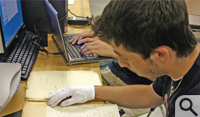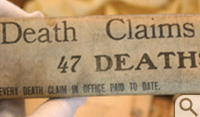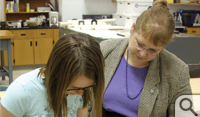Freshman discoveries: W&M students make historical find in Richmond
Sharpe scholars walk into an old building, walk out with a cache of lost documents
Without so much as a map or an “X” to mark the spot, a group of Sharpe Scholars uncovered a historical treasure.
Their find will shed new light on the lives of early 20th-Century African Americans.
The group discovered a cache of original documents related to the life and work of Maggie L. Walker, the first female to found a bank in the United States and a “womanist” who worked tirelessly to improve the lives of other black women.
The students were exploring the attic of a building in Richmond when they came across piles of 1920s and ’30s documents associated with the Independent Order of St. Luke, an organization led by Maggie Walker that was dedicated to helping improve the lives of African Americans during the Jim Crow era. The documents include letters from Walker, insurance papers and rare copies of the organization’s newspaper, doubling the number known to exist.
“When you have these all together, it gives you a fabulous film over time of how people were living and dying in this area,” said Heather Huyck, an adjunct associate professor at William & Mary. “It’s a really fascinating treasure for historians and for the general public. It will help us better understand all American history.”
Third year of a freshman seminar
 The discovery comes three years after Huyck, a former National Park Service employee, began teaching a freshman seminar on the St. Luke Building and its historical context. The seminar is part of the College’s Sharpe Community Scholars Program. The program takes freshmen, teaches them about community issues and then asks the students to address those issues through student-generated projects.
The discovery comes three years after Huyck, a former National Park Service employee, began teaching a freshman seminar on the St. Luke Building and its historical context. The seminar is part of the College’s Sharpe Community Scholars Program. The program takes freshmen, teaches them about community issues and then asks the students to address those issues through student-generated projects.
Huyck began teaching the seminar in hope of preserving the St. Luke Building just off of I-95 in downtown Richmond. During the early 20th Century the building served as an economic powerhouse in the Jackson Ward community. Through the Independent Order of St. Luke, Maggie Walker used her entrepreneurial skills to fill needs otherwise denied to African Americans during that era, creating insurance, a bank and a newspaper—“the tools and institutions that helped people be middle class,” Huyck said. Under Walker’s 35 years of leadership, the order grew to include more than 100,000 members in 24 states and provided professional jobs for African American women and safe meeting places for African Americans “in the middle of Jim Crow, which sought to thwart their aspirations in every way it could,” said Huyck.
Walker’s home, at 101/2 E. Leigh Street in Richmond, is a National Historic Site administered by the National Park Service, but the four-story St. Luke Building, boarded up and vacant, has been largely ignored. Huyck and her students have been trying to change the building’s status by working toward getting the site designated as a National Historic Landmark.
With permission from the Stallings family, which owns the building, Huyck’s students have been inside St. Luke’s before. However, because it is vacant and deteriorated, they had not done much exploring. Huyck knew there were boxes in the attic; however, she had never been up to investigate them herself.
‘Just doing a video’
 At the end of February 2009, a group of Huyck’s students were in the St. Luke Building with Ron Stallings as he gave an oral history.“We were just doing a video of the owner walking through the building,” Lindsey Nicolai ’12 said. “Mr. Stallings said, ‘You know, I’ve never been up to the attic yet.’”
At the end of February 2009, a group of Huyck’s students were in the St. Luke Building with Ron Stallings as he gave an oral history.“We were just doing a video of the owner walking through the building,” Lindsey Nicolai ’12 said. “Mr. Stallings said, ‘You know, I’ve never been up to the attic yet.’”
So everyone decided to climb the narrow stairway and look at the attic. At first, they saw some old props and an aisle seat from the building’s original center auditorium. They also saw boxes full of documents from when the building housed a daycare in the 1970s. As they continued to explore the space by the light of their flashlights, a cell phone and a light for their video camera, one student picked up a piece of paper that would change everything.
It was a 1930s “death card”—an insurance card that recorded someone’s death and the related payout information.
“We got really excited, and we started moving boxes out of the way and picking up stuff,” said Amy Clinger ’11, a Sharpe Fellow who was leading the group of students that day.
When the students began moving aside the boxes of 1970s documents, they revealed stacks of papers from the 1920s and ’30s.
“At that moment, my first thought was one of disbelief,” Nicolai said. “After we had learned that many people thought these documents were lost forever, I thought it impossible that we had discovered even a few of those long-lost documents.”
Among their findings, the students discovered four copies of the St. Luke Herald. Previously, only four were known to be in existence. They also discovered stacks of the death cards, letters from Walker to other organizations and various other documents from the businesses that once existed in the building.
“It was like a big treasure hunt,” said Clinger. “We were excited—very, very excited. We were on a high all day long.”
A renegotiated dinner
 Huyck had told the students to let her know when they were done in the building that day. She was shopping with her husband when her cell phone rang.
Huyck had told the students to let her know when they were done in the building that day. She was shopping with her husband when her cell phone rang.
“It was a delirious Amy and I could hear all this giggling in the back,” said Huyck. “I had lightly said to them if anybody finds another copy of the St. Luke Herald, I would take them to dinner at the Williamsburg Inn. This was a mistake. I had to renegotiate that dinner—it’ll be at our house instead.”
With the permission of Stallings, the students removed six boxes of documents from the building that first day. Stallings stored those documents in another one of his buildings, and the students took a few samples back to Williamsburg to show Huyck. She immediately realized how much the documents could tell about African American women’s lives.
Later that week, the students returned with Huyck and several National Park Service employees to remove the rest of the documents from the attic. Altogether, the students carried out 31 boxes.
Once they were all removed, the group had to decide what to do with them. That process showed the students about doing history work in “real time,” said Huyck.
“They’ve been in an attic for 80 years, with zero climate control and zero security, but somebody had carefully placed the St. Luke documents under the newer papers to protect them and had carried all those boxes up the stairs,” said Huyck. “They go from non-existent to being sacrosanct, and we’re trying to figure out how to make that transition. We want to do what’s best for the documents and for the students’ education. The students found these documents!”
Finally, it was decided that the documents would be given to the National Park Service, but the students would get them for about a year to copy and catalog them. Because the papers have been in the attic for decades, they are covered with soot and dust. With training from the park service, the students began using a lab at William & Mary to do their work in April. Because of the number of documents, which are being stored in the Swem Library’s Special Collections Research Center, the students believe the work will continue through next semester.
Serendipitously, most of the six students who made the discovery are part of the seminar’s document team. The other two teams include one that is enhancing the Maggie Walker National Historic web site and another that is producing a folder on the St. Luke Building. Originally, the document team was hoping to, at best, find old newspaper clippings and documents from members of the community.
“This is the kind of stuff we thought we’d never find, or we thought we’d find like one letter,” said Clinger. “But instead we found something much more important.”
Documents of a rare type
Huyck said the documents hold a wealth of information for both the students and other historians to explore.
“It has incredible research value. African American women’s history is one of the toughest fields in terms of records,” said Huyck. “These people were poor; many of them had been enslaved.”
As the Sharpe seminar starts cataloguing and copying the documents, it becomes clear that the find will illuminate scholars’ understanding of life under Jim Crow. Correspondence to Maggie Walker—as well as copies of letters she sent out—will show the links the St. Luke organization had with other social and political organizations. The paperwork of the insurance arm of the order reveals data of a more personal nature.
“It tells us how people died. It tells us where people actually were. It tells us how everything actually worked,” Huyck said.
Clinger said that going through the documents—seeing the information on the death cards and letters signed by Maggie Walker—has helped her and the other students see the personal aspects of both Walker’s life and her businesses.
“I know history can be kind of boring to people sometimes,” she said. “But this brought a sense of adventure for the students. History can be exciting, not just in researching it but in these kinds of finds and processing them and getting to know this historical figure as a person—someone who did write letters, someone who signed her letters, sealed them and worked with these people that were going through these really difficult times.” 
















